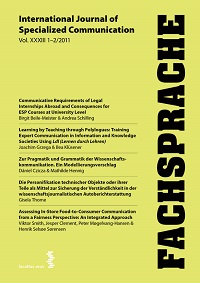Assessing In-Store Food-to-Consumer Communication from a Fairness Perspective: An Integrated Approach
Main Article Content
Article Sidebar
Abstract
This article addresses a highly specialised form of communication that most people in the industrialised world engage in every day: The one-way communication between a food
product and an individual consumer who is considering buying the product during his or her daily shopping in a supermarket. In addition to identifying and analysing the key variables of this form of communication, we focus on how the outcome is best evaluated in terms of fairness. Using an in-depth review of 821 Danish administrative cases on misleading food naming and labelling as an empirical frame of reference, we set up a cross-disciplinary conceptual framework and meta-language suited for identifying and analysing the conflict scenarios displayed by these cases beyond the common-sense reasoning that dominates the argumentation of the immediate actors (companies, consumers, authorities) today. A key aim is to provide a conceptual basis for predicting and systematically testing the misleading potential of specific food labelling solutions on empirical grounds, as a supplement to testing consumer liking, preference, and choice, which has been the main focus in adjacent, mostly marketing-oriented research.

